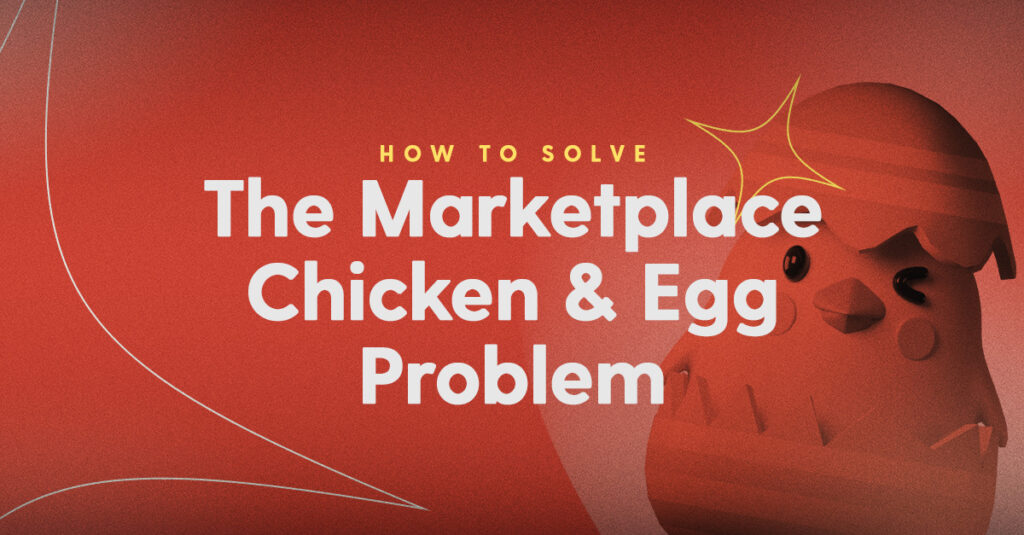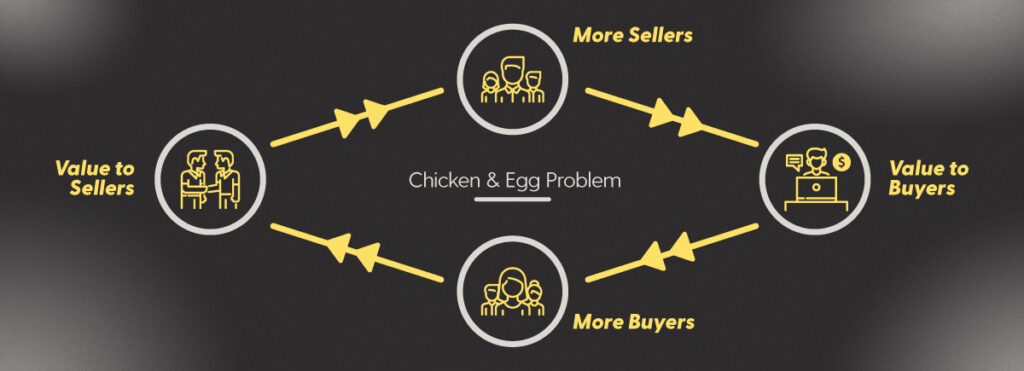
Must have features for your online marketplace platform. (2025)
Learn – Dittofi News Must have features for your online marketplace platform. (2024) Discover the must-have features for your online marketplace platform. From buyer and

A two-sided marketplace has a unique problem to solve.
It has two very dissimilar customer segments & it must attract both of them. This is comparable to building two different businesses.
On one side the marketplace has buyers & on the other side it has sellers. Often both customer segments are very different & need to be attracted using different channels.
The problem is, even when you attract one side of the marketplace, either the buyer or the seller, the buyer doesn’t get value out of the marketplace without the seller & the seller doesn’t get value without the buyer. This leads to a vicious cycle often referred to as the marketplace “chicken and egg problem”.

There are various strategies that you can use to solve the marketplace chicken and egg problem.
In this article we take a look at actionable strategies used by companies such as Airbnb, Uber, Outdoorsy, Eventbrite, Thumbtack, Craigslist, Indeed & many more to solve the marketplace chicken and egg problem.
You can use these strategies, or a combination of these strategies to get users onto your own marketplace. You should be careful when selecting which strategy to follow. Each business is unique so, consider these examples as inspiration rather than something to be directly copied.
A complete list of the strategies we will look at include:
With a two-sided marketplace you need to generate both supply & demand. However, it is impossible to build both sides at the same time. Therefore, you need to focus on getting one side initially onto the marketplace.
Many people think that getting the supply side on is the best side to start. This is because vendors who believe that they will increase their revenue by listing their products or services on your site, will be more willing to wait for the demand side to arrive. However, it is not always the case. In some instances it makes more sense to focus on getting the demand side first.
Therefore, rule number 1 if solving the chicken & egg problem is to focus on getting the hardest side on the marketplace first.
Below are two successful marketplaces, one that focused initially on the supply side & the other on the demand side.
In the United States there was a shortage of RV owners. Outdoorsy therefore started by trying to get the Recreational Vehicles (RVs) on the platform first.
To get the RVs on the platform, the founders drove across the United States of America, visiting small & unfamiliar towns that most people had never heard of. Along the way they made 1200 personal calls to RV owners that they found on Craigslist, walked up to campers & interviewed them & learnt about all of the hassle of owning an RV.
They found out that one of the major blockers for RV owners to rent their RV was that they needed a custom built insurance policy to protect the RV owners & renters. The founders paid a substantial amount of money for an insurance company to create the required bespoke insurance policy for RV renters.
Once the team at outdoorsy got a strong base of RV owners to list their vehicles on the site, they then set off in an expedition in content capture. This enabled them to tell a story showcasing what it was like to rent an RV & how the Outdoorsy product works.
Catalant is a marketplace that connects businesses with skilled consultants who are able to execute on their projects. The way it works, businesses will post work on the Catalant marketplace, identifying details about their project (for example, start date, end date, budget, skill sets, background & so on). Freelance consultants will then find project postings on the marketplace & submit proposals.
So – on one side you have businesses on the demand side & consultants on the supply side. Which is the hardest to find?
Well, the Catalant team found that it was much harder to find the businesses that needed consultants. They therefore focused very hard on finding corporations to list their projects. Once Catalant had developed a sufficient amount of demand, they then went over to find the supply side.
The best results are achieved as a result of focus. To test their product or service, companies that become successful always start in a small market.
There are two ways to restrict the market. The first way is to restrict it by category and the second way is to restrict it by geography. It is prudent to restrict your market because it allows you to deploy the company resources more effectively. Once the company has found a concept that can generate revenue, they can then expand their vision.
Let’s take a look at how marketplaces started by focusing on a niche market.
Uber initially focused their idea by category & geography. They launched as a premium black car service in San Francisco in 2010. To find black cars and professional drivers for its service, Uber developed partnerships with existing limousine & chauffeur companies in the area. Uber reached out to these companies & collaborated with them to make their vehicles & drivers available through the Uber platform.
By leveraging these partnerships, Uber was able to offer customers access to high-quality black car services in San Francisco through their mobile app. As Uber expanded, it introduced various service tiers & vehicle options, including UberX, which includes more affordable rides from everyday drivers, but its initial foray into the market began with black cars sourced from existing professional transportation providers.
eBay was founded in 1995 by Pierre Omidyar. Its initial niche target market was collectors of unique & rare items. Omidyar originally created the platform as an online marketplace called “AuctionWeb”, where people could buy & sell collectibles such as Pez dispensers & Beanie Babies.
The idea behind eBay was to create a virtual marketplace that would connect collectors & enthusiasts who were interested in trading & buying these niche items. It quickly gained popularity within the collector community, & as more people discovered the platform’s potential, eBay expanded to include a wider range of products and categories. Nowadays eBay is a global e-commerce giant, covering everything from electronics and fashion to automobiles and more.
Many marketplaces pay their most valuable members of the marketplace in order to get them onto their platform. This is known as burning cash to buy revenue. Companies that have done this include Uber, Helix, ClassPass, DoorDash & many more.
In this section we take a look at several companies who burnt cash to buy revenue.
When Uber entered new markets, they famously subsidized drivers heavily with cash incentives. Uber would pay their drivers to drive around all day so that there was a ready pool of supply to satisfy demand. Uber also subsidized the cost of the taxi rides making rides cheaper than taxis by covering the cost of part of the ride. By doing this, they were able to attract huge demand & a huge pool of cars, large enough to offer an instant service to customers.
Once Uber had enough drivers to control the supply of cars, they were able to push up the price of their Uber rides. This meant that on May 18th 2022, an Uber from JFK Airport to Manhattan was $100 – nearly double the fixed yellow cab rate. But there were no yellow cabs available, as those drivers are now driving Ubers.
Uber & Lyft both ran this strategy, spending billions in investor funding to corner the ride-hailing market.
ClassPass gives you access to thousands of gyms & studios where you can go to participate in group workouts such as boxing, dance, spinning & so on.
The platform started off by approaching gyms & studios & negotiating discounted access for their members. For instance, if a class costs $20 to attend, ClassPass members would be able to attend for $10 per class. ClassPass then sold unlimited access to classes for $100 per month. The idea was, if you went to the class more than 10 times in 1 month, ClassPass would make a loss. However, if you went less than 10 times, ClassPass made a profit. The video below explains how this works.
In 2017, after attracting a lot of early adopters with this business model, ClassPass realized that their most active users were going to class more than anticipated. This forced them to switch their business model to a more sustainable credit based system.
One approach that is often overlooked is the “offline approach” which involves physically meeting up with your target audience. As we’ve already seen, Outdoorsy took an offline approach to get the first set of RV hosts on their site. In this section, we take a look at other marketplaces that solved the chicken & egg problem by physically meeting up with startups.
Note that most physical meetups don’t work for marketplaces because they don’t scale well. However, having a few physical meetups & being loud about it on social media can help to drive eyeballs to your platform & also create some really intense users of your product.
Etsy, the online marketplace for handmade & vintage goods, adopted an offline approach to kickstart their marketplace. The Etsy founders started off by visiting craft fairs across the United States & Canada. The goal was to find influential craft vendors & to help them to set up an online store on their site. The founding team knew that if they could get artists / crafters that were influential to set up stores on their site then others would quickly follow.
One of the methods that Poshmark used to engage sellers on their platform was to throw physical parties. These parties were known as Posh ‘N Sip & can be most closely described as one part ’70s Tupperware party & three parts business meetup. Attendees would spend around one quarter of their time showing off their inventory & the other three quarters of their time discussing business tips such as the challenges of transitioning from a physical store to a digital one, how to do inventory management & so on.
These local events led to lots of social media presence which led to lots of exposure for Poshmark & became one of the primary ways that Poshmark were able to engage sellers. In 2019 Poshmark ran 546 such local events in 38 states.
In 2005 Myspace was the top social network, Facebook was just launching & Twitter did not exist. User generated content existed, but it was not being done well by anyone. Yelp’s challenge was to get real people to share real opinions on local businesses – without using money as an incentive to get them to write.
To do this, they identified Yelp users who bought into the review writing process. They liked their posts, commented below them, shared them with friends & so on. These early adopters were made part of local tribes called the “Yelp Elite Squad”. The Yelp Elite Squad were invited to physical parties, given platinum cards & made to feel like the tastemakers of San Francisco. Some were turned into Yelp Community Managers.
Thus, by creating the converted position of the Yelp Elite Squad, Yelp were able to get regular people to write reviews. With SEO doing its thing in the background, this helped turn Yelp into a popular & credible source of reviews.
Many marketplaces use automation to create the impression of a massive supply on the marketplace. This is done so that when potential users of the demand side come to the platform, they are more likely to engage with it because they see that many profiles of the other side are already there. Sometimes it is smart to not ask for permission before scraping data.
In this section we take a look at some of the companies who have successfully used automation to seed their supply.
Before Indeed existed, job seekers had to visit hundreds of sites to find relevant jobs – a centralized marketplace for job listings did not exist. To solve this problem, Indeed built an aggregation technology that pulled data from multiple job boards, career pages of company websites, staffing websites & so on. Indeed then normalised all of this data into a single, searchable repository.
Once Indeed had the data, they were able to attract more Job Seekers & focused heavily on building a tool for Job Seekers. As Indeed gained popularity, it also began forming partnerships with employers to receive job listings directly, reducing the reliance on their aggregation technology.
As mentioned above, Yelp was founded at a time when user generated content was in its infancy. This was a challenge for the platform that needed to generate “real reviews by real people”.
To kick start the process of building their platform for their new review system, Yelp purchased a database of over 20 million business locations. This database was old and inaccurate, but it created the framework for what Yelp called “claimed business locations”.
Once Yelp had the database, they set up empty business pages that functioned as an open invitation for people to submit reviews. It motivated people to, at the very least, write a few words about the business. In fact, many of the early reviews were just that: “this place is great”, or “this place sucked.” But as time passed, reviewers started to take the platform more seriously and write longer, deeper reviews. The framework paid off in dividends later.
If you build a valuable tool for either the supply side or the demand side of a marketplace, the users will come to you even when the other side of the marketplace is not there. A future marketplace could start as a Software as a Service (SaaS) & then transition into a marketplace as it starts to generate more activity.
In this section we take a look at marketplaces that started by building useful tools for one side of the marketplace.
OpenTable developed a table reservation software for restaurants. The solution was an Electronic Reservation Book which replaced the restaurant pen & paper reservation systems, handling reservation management, table management, guest recognition, and email marketing.
Once OpenTable realized that they had amassed enough restaurants in a certain area, they opened up their platform for restaurant goers. By doing this OpenTable brought even more guests to the restaurants & allowed them to charge a commission fee for introducing new guests to the restaurants.
Thumbtack, a local services marketplace with a $1.3 billion valuation solved the chicken & egg problem by developing a simple tool for service based professionals to post ads up on Craigslist. This allowed them to generate a database of suppliers which they were then able to use to attract demand for the services.
Eventbrite began its life as a ticketing platform for event organisers in the mid market. Their solution helped event organisers sell tickets in a self-serve way. Once they had attracted a large number of ticket sellers, Eventbrite invested in developing tools for event goers to discover & attend events. This included the development of search features, entry management, venue management & so on.
Email lists are important because email marketing is the best way to connect with customers compared with social media. In fact, you are 6x more likely to get a click-through from an email vs. tweets. Email is also 40 times more effective at acquiring new customers than social media platforms Facebook, Instagram or Twitter.
In this section, we look at some examples of marketplaces that built one side of their marketplace as an email list first.
The founder of CraigsList, Craig Newmark, moved to the San Francisco Bay Area in 1995. New in town, Craig had no friends & felt like any other isolated newcomer to the Bay Area. Craig was a member of online communities such as the WELL, which helped community members in a friendly, social & trusting manner. Inspired by these online communities, Craig decided to create something similar for local events.
In early 1995, Craig began an email distribution list to friends. Most of the early emails were just Craig posting notices of art & technical events that were taking place in the local area. Through manual advertising within his local community, the number of subscribers to the email list increased & people started to ask Craig if he would email out a job posting or listing of something to sell.
As the mailing list kept growing, Craig developed a simple HTML website where users could post up their listings. However, Craig continued to operate the email distribution list as this was what most people were interested in. The list used a simple CC mechanism that broke after he hit 240 users & forced him to move to a more robust email distribution software.
As Craig recalled in an interview with Computer World in 2007, Craig said that he can’t remember when people started being more interested in the website than the email list, but thinks that it occurred sometime in the year 2000.
Threadless was founded in 2000 by Jake Nickell & Jacob DeHart. The origin story of threadless normally starts with a small website for designers & illustrators called “Dreamless”. According to an article in the Chicago Mag, Nickell entered into a design contest on Dreamless & won, winning no prize money.
Thinking that prize money would make the contest more competitive, Nickell decided to create a contest of his own, offering $500 prize money to the winner. This prize money was matched by another Dreamless member, DeHart. Both the contest & the prize money were posted on a Dreamless thread, inspiring the name “Threadless”.
The winning design won the prize money & Nickell & DeHart printed the winning design on a t-shirt (of course crediting the original artist). The t-shirts were then sold & the designer remunerated.
After running several similar contests, Threadless was officially born. By this time, Threadless had amassed a large number of emails for designs & designers who subscribed to their quirky but intimate community. Having originally seeded their email list from the Dreamless thread, Nickell & DeHart increased awareness for the company by participating in online messaging boards, forums & blogs. This approach was used rather than paid advertisements as it gave the Threadless company a more intimate feel.
You will often hear investors talk about the importance of “doing things that scale”. This means putting in place processes, technology & strategies that can expand efficiently as your business grows &, without significantly increasing resources or costs.
Doing things that scale is important however, “doing things that DON’T scale” in the early days can give you critical insights into each step of the transaction process & allow you to manufacture an excellent process that can be streamlined the more you understand it. In this section we take a look at several companies that manually connected both sides to start with.
The first version of Amazon’s online marketplace of everything, comprised of a website (Amazon.com), a list of books and Geoff Bezos filling orders manually. That was it!
When a customer ordered the book, Jeff would physically drive to a book shop, buy the book from the distributor and mail it to the client. That was Amazon’s MVP and it started to earn them money and got them customers.
From there, Jeff & his team worked relentlessly to improve that process & has now developed a streamlined marketplace that can ship physical goods to buyers in under 24 hours.
Nick Swinmurn went shoe shopping for a pair of Airwalk Desert boots. He found the color he wanted, but not the size. Then he found a size that fit, but not in the color he wanted. Nick left the shopping mall without buying any shoes & later founded what is today known as Zappos.
To get Zappos going, Nick met with Venture Frogs, an investment company founded by Tony Hsieh. Nick convinced Tony to invest $500 million into Zappos & Tony became co-CEO with Nick.
From the start, Nick & Tony wanted Zappos to be known for wowing their customers and delivering the best customer service. This went as far as the founders Nick & Tony, as well as employees, personally delivering shoes directly to customers living in the Las Vegas area. As a direct result of Zappos’ excellent customer service, in 2022, seventy-five percent of its business came from repeat customers, even though Zappos prices are far from the lowest.
In this article we have looked at several strategies & examples of how to solve the marketplace chicken & egg problem & get your company off the ground.
These strategies can also work for you however, you must remember, successfully solving the marketplace chicken and egg problem often hinges on a deep understanding of your target audience combined with a well-thought-out strategy. Blindly copying another company’s solution may not resonate well with your target audience. Therefore, treat these strategies as inspiration for your business, but tailor them for your target audience.
Finally, don’t be afraid to try multiple strategies & give time for each strategies to play out. Building a multi million dollar marketplace takes years & you only get there through relentless effort & grind.
I hope this collection of case studies was helpful! If you need a marketplace, check out Dittofi’s marketplace solutions or speak with a member of team who will help advise you on how to build a quality, high performance & feature rich marketplace solution.


Must have features for your online marketplace platform. (2025)
Learn – Dittofi News Must have features for your online marketplace platform. (2024) Discover the must-have features for your online marketplace platform. From buyer and

Peer to peer marketplaces: Your comprehensive handbook
Learn – Dittofi Marketplace Insider Series How to Build a Peer to Peer Marketplace (2025 Guide) Welcome to our comprehensive handbook on peer-to-peer marketplaces. From

How to design a two-sided marketplace transaction flow
Learn – Dittofi News How to design a two-sided marketplace transaction flow: A Step-by-Step Guide (2025) Etsy has transformed the way people buy and sell
Enter your email below and we will email you a free copy of one of our best guides (28 pages)
Enter your email below and we will email you a free copy of one of our best guides (28 pages)
⸺ Receive the latest news
Get notified about new articles and events